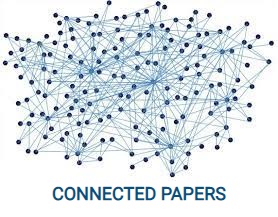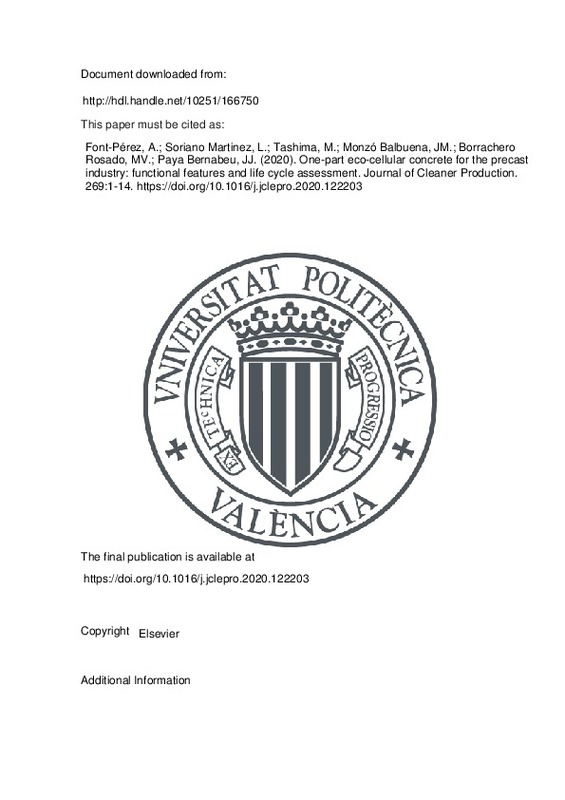Bai, C., & Colombo, P. (2018). Processing, properties and applications of highly porous geopolymers: A review. Ceramics International, 44(14), 16103-16118. doi:10.1016/j.ceramint.2018.05.219
Bouzón, N., Payá, J., Borrachero, M. V., Soriano, L., Tashima, M. M., & Monzó, J. (2014). Refluxed rice husk ash/NaOH suspension for preparing alkali activated binders. Materials Letters, 115, 72-74. doi:10.1016/j.matlet.2013.10.001
Chen, Y.-L., Ko, M.-S., Chang, J.-E., & Lin, C.-T. (2018). Recycling of desulfurization slag for the production of autoclaved aerated concrete. Construction and Building Materials, 158, 132-140. doi:10.1016/j.conbuildmat.2017.09.195
[+]
Bai, C., & Colombo, P. (2018). Processing, properties and applications of highly porous geopolymers: A review. Ceramics International, 44(14), 16103-16118. doi:10.1016/j.ceramint.2018.05.219
Bouzón, N., Payá, J., Borrachero, M. V., Soriano, L., Tashima, M. M., & Monzó, J. (2014). Refluxed rice husk ash/NaOH suspension for preparing alkali activated binders. Materials Letters, 115, 72-74. doi:10.1016/j.matlet.2013.10.001
Chen, Y.-L., Ko, M.-S., Chang, J.-E., & Lin, C.-T. (2018). Recycling of desulfurization slag for the production of autoclaved aerated concrete. Construction and Building Materials, 158, 132-140. doi:10.1016/j.conbuildmat.2017.09.195
Chica, L., & Alzate, A. (2019). Cellular concrete review: New trends for application in construction. Construction and Building Materials, 200, 637-647. doi:10.1016/j.conbuildmat.2018.12.136
Choo, H., Lim, S., Lee, W., & Lee, C. (2016). Compressive strength of one-part alkali activated fly ash using red mud as alkali supplier. Construction and Building Materials, 125, 21-28. doi:10.1016/j.conbuildmat.2016.08.015
Colangelo, F., Forcina, A., Farina, I., & Petrillo, A. (2018). Life Cycle Assessment (LCA) of Different Kinds of Concrete Containing Waste for Sustainable Construction. Buildings, 8(5), 70. doi:10.3390/buildings8050070
Dahmen, J., Kim, J., & Ouellet-Plamondon, C. M. (2018). Life cycle assessment of emergent masonry blocks. Journal of Cleaner Production, 171, 1622-1637. doi:10.1016/j.jclepro.2017.10.044
De Moraes Pinheiro, S. M., Font, A., Soriano, L., Tashima, M. M., Monzó, J., Borrachero, M. V., & Payá, J. (2018). Olive-stone biomass ash (OBA): An alternative alkaline source for the blast furnace slag activation. Construction and Building Materials, 178, 327-338. doi:10.1016/j.conbuildmat.2018.05.157
Esmaily, H., & Nuranian, H. (2012). Non-autoclaved high strength cellular concrete from alkali activated slag. Construction and Building Materials, 26(1), 200-206. doi:10.1016/j.conbuildmat.2011.06.010
Font, A., Borrachero, M. V., Soriano, L., Monzó, J., Mellado, A., & Payá, J. (2018). New eco-cellular concretes: sustainable and energy-efficient materials. Green Chemistry, 20(20), 4684-4694. doi:10.1039/c8gc02066c
Font, A., Borrachero, M. V., Soriano, L., Monzó, J., & Payá, J. (2017). Geopolymer eco-cellular concrete (GECC) based on fluid catalytic cracking catalyst residue (FCC) with addition of recycled aluminium foil powder. Journal of Cleaner Production, 168, 1120-1131. doi:10.1016/j.jclepro.2017.09.110
Font, A., Soriano, L., de Moraes Pinheiro, S. M., Tashima, M. M., Monzó, J., Borrachero, M. V., & Payá, J. (2020). Design and properties of 100% waste-based ternary alkali-activated mortars: Blast furnace slag, olive-stone biomass ash and rice husk ash. Journal of Cleaner Production, 243, 118568. doi:10.1016/j.jclepro.2019.118568
Font, A., Soriano, L., Moraes, J. C. B., Tashima, M. M., Monzó, J., Borrachero, M. V., & Payá, J. (2017). A 100% waste-based alkali-activated material by using olive-stone biomass ash (OBA) and blast furnace slag (BFS). Materials Letters, 203, 46-49. doi:10.1016/j.matlet.2017.05.129
Hajimohammadi, A., Ngo, T., Mendis, P., Kashani, A., & van Deventer, J. S. J. (2017). Alkali activated slag foams: The effect of the alkali reaction on foam characteristics. Journal of Cleaner Production, 147, 330-339. doi:10.1016/j.jclepro.2017.01.134
Hassan, H. S., Abdel-Gawwad, H. A., García, S. R. V., & Israde-Alcántara, I. (2018). Fabrication and characterization of thermally-insulating coconut ash-based geopolymer foam. Waste Management, 80, 235-240. doi:10.1016/j.wasman.2018.09.022
He, J., Gao, Q., Song, X., Bu, X., & He, J. (2019). Effect of foaming agent on physical and mechanical properties of alkali-activated slag foamed concrete. Construction and Building Materials, 226, 280-287. doi:10.1016/j.conbuildmat.2019.07.302
Kamseu, E., NGouloure, Z. N. M., Ali, B. N., Zekeng, S., Melo, U. C., Rossignol, S., & Leonelli, C. (2015). Cumulative pore volume, pore size distribution and phases percolation in porous inorganic polymer composites: Relation microstructure and effective thermal conductivity. Energy and Buildings, 88, 45-56. doi:10.1016/j.enbuild.2014.11.066
Keawpapasson, P., Tippayasam, C., Ruangjan, S., Thavorniti, P., Panyathanmaporn, T., Fontaine, A., … Chaysuwan, D. (2014). Metakaolin-Based Porous Geopolymer with Aluminium Powder. Key Engineering Materials, 608, 132-138. doi:10.4028/www.scientific.net/kem.608.132
Luukkonen, T., Abdollahnejad, Z., Yliniemi, J., Kinnunen, P., & Illikainen, M. (2018). One-part alkali-activated materials: A review. Cement and Concrete Research, 103, 21-34. doi:10.1016/j.cemconres.2017.10.001
Luukkonen, T., Abdollahnejad, Z., Yliniemi, J., Kinnunen, P., & Illikainen, M. (2018). Comparison of alkali and silica sources in one-part alkali-activated blast furnace slag mortar. Journal of Cleaner Production, 187, 171-179. doi:10.1016/j.jclepro.2018.03.202
Ma, C., Zhao, B., Guo, S., Long, G., & Xie, Y. (2019). Properties and characterization of green one-part geopolymer activated by composite activators. Journal of Cleaner Production, 220, 188-199. doi:10.1016/j.jclepro.2019.02.159
Mellado, A., Catalán, C., Bouzón, N., Borrachero, M. V., Monzó, J. M., & Payá, J. (2014). Carbon footprint of geopolymeric mortar: study of the contribution of the alkaline activating solution and assessment of an alternative route. RSC Adv., 4(45), 23846-23852. doi:10.1039/c4ra03375b
Moraes, J. C. B., Font, A., Soriano, L., Akasaki, J. L., Tashima, M. M., Monzó, J., … Payá, J. (2018). New use of sugar cane straw ash in alkali-activated materials: A silica source for the preparation of the alkaline activator. Construction and Building Materials, 171, 611-621. doi:10.1016/j.conbuildmat.2018.03.230
Novais, R. M., Buruberri, L. H., Seabra, M. P., Bajare, D., & Labrincha, J. A. (2016). Novel porous fly ash-containing geopolymers for pH buffering applications. Journal of Cleaner Production, 124, 395-404. doi:10.1016/j.jclepro.2016.02.114
Novais, R. M., Senff, L., Carvalheiras, J., Seabra, M. P., Pullar, R. C., & Labrincha, J. A. (2019). Sustainable and efficient cork - inorganic polymer composites: An innovative and eco-friendly approach to produce ultra-lightweight and low thermal conductivity materials. Cement and Concrete Composites, 97, 107-117. doi:10.1016/j.cemconcomp.2018.12.024
Peys, A., Rahier, H., & Pontikes, Y. (2016). Potassium-rich biomass ashes as activators in metakaolin-based inorganic polymers. Applied Clay Science, 119, 401-409. doi:10.1016/j.clay.2015.11.003
Puertas, F., & Torres-Carrasco, M. (2014). Use of glass waste as an activator in the preparation of alkali-activated slag. Mechanical strength and paste characterisation. Cement and Concrete Research, 57, 95-104. doi:10.1016/j.cemconres.2013.12.005
Robayo-Salazar, R., Mejía-Arcila, J., Mejía de Gutiérrez, R., & Martínez, E. (2018). Life cycle assessment (LCA) of an alkali-activated binary concrete based on natural volcanic pozzolan: A comparative analysis to OPC concrete. Construction and Building Materials, 176, 103-111. doi:10.1016/j.conbuildmat.2018.05.017
Stoleriu, S., Vlasceanu, I. N., Dima, C., Badanoiu, A. I., & Voicu, G. (2019). Alkali activated materials based on glass waste and slag for thermal and acoustic insulation. Materiales de Construcción, 69(335), 194. doi:10.3989/mc.2019.08518
Sturm, P., Gluth, G. J. G., Brouwers, H. J. H., & Kühne, H.-C. (2016). Synthesizing one-part geopolymers from rice husk ash. Construction and Building Materials, 124, 961-966. doi:10.1016/j.conbuildmat.2016.08.017
Van den Heede, P., & De Belie, N. (2012). Environmental impact and life cycle assessment (LCA) of traditional and ‘green’ concretes: Literature review and theoretical calculations. Cement and Concrete Composites, 34(4), 431-442. doi:10.1016/j.cemconcomp.2012.01.004
Xuan, D., Tang, P., & Poon, C. S. (2019). MSWIBA-based cellular alkali-activated concrete incorporating waste glass powder. Cement and Concrete Composites, 95, 128-136. doi:10.1016/j.cemconcomp.2018.10.018
Yang, K.-H., Lee, K.-H., Song, J.-K., & Gong, M.-H. (2014). Properties and sustainability of alkali-activated slag foamed concrete. Journal of Cleaner Production, 68, 226-233. doi:10.1016/j.jclepro.2013.12.068
Zabalza Bribián, I., Valero Capilla, A., & Aranda Usón, A. (2011). Life cycle assessment of building materials: Comparative analysis of energy and environmental impacts and evaluation of the eco-efficiency improvement potential. Building and Environment, 46(5), 1133-1140. doi:10.1016/j.buildenv.2010.12.002
Ziegler, D., Formia, A., Tulliani, J.-M., & Palmero, P. (2016). Environmentally-Friendly Dense and Porous Geopolymers Using Fly Ash and Rice Husk Ash as Raw Materials. Materials, 9(6), 466. doi:10.3390/ma9060466
[-]







![[Cerrado]](/themes/UPV/images/candado.png)


